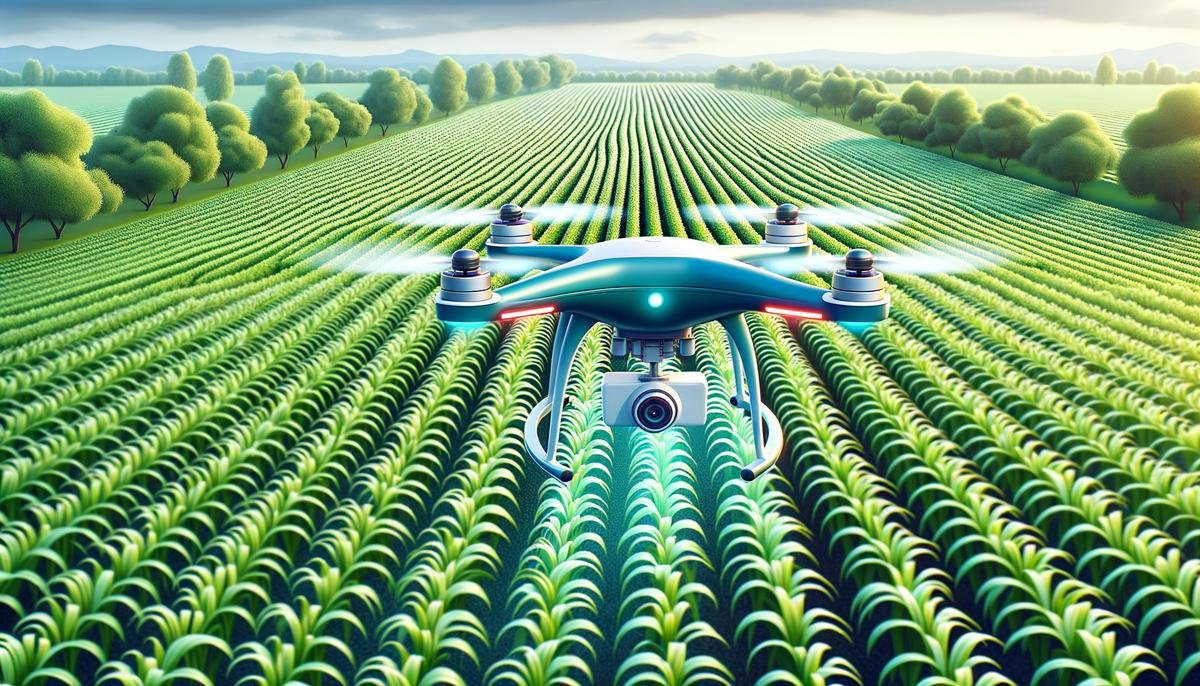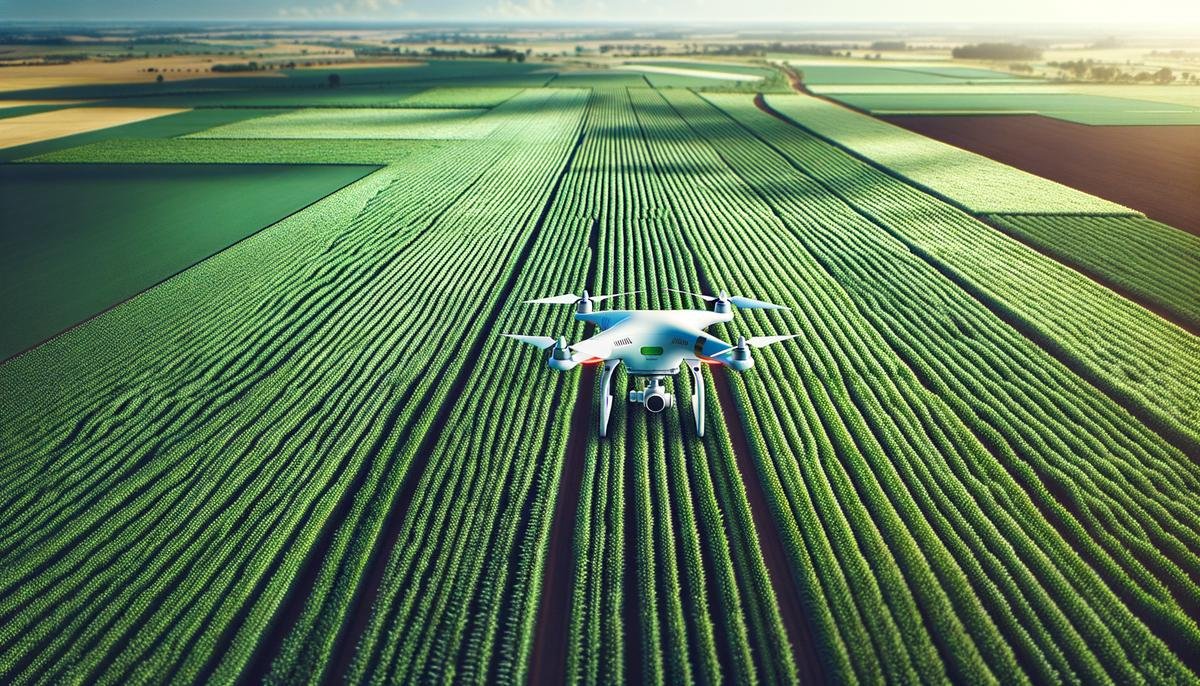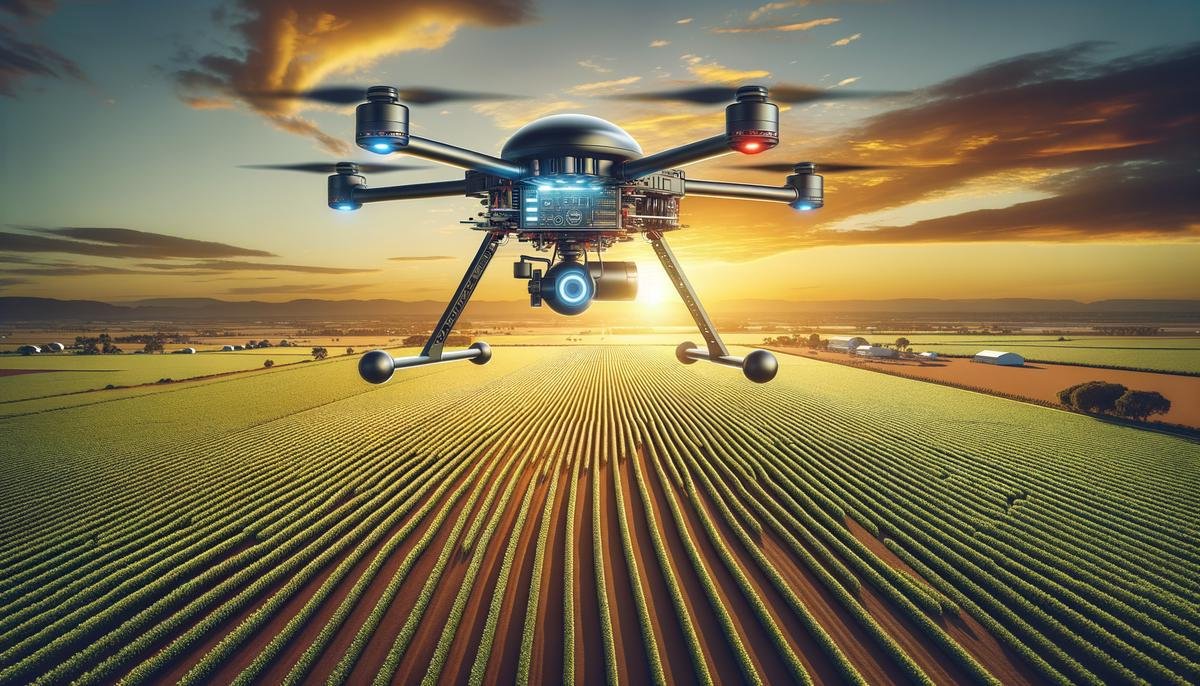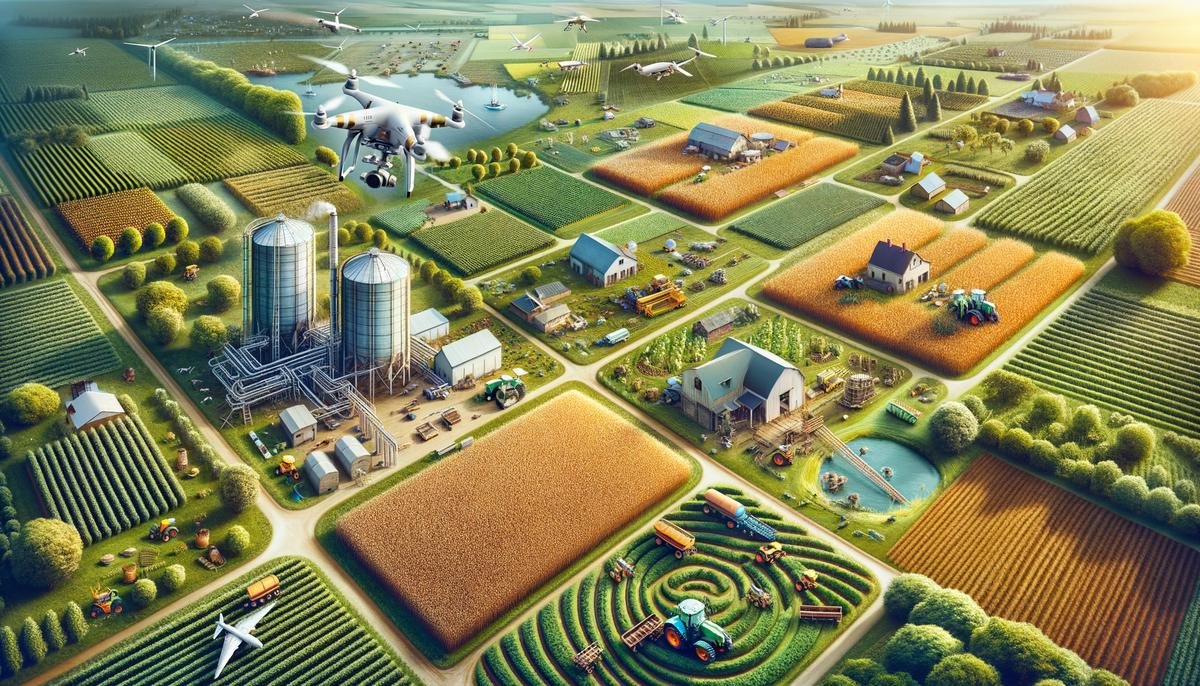Taranis is revolutionizing the agricultural sector by integrating drone technology into farming practices, offering a fresh perspective on crop management and resource optimization. This approach provides farmers with detailed insights into their fields, enabling proactive measures that were previously unattainable. As we examine the impact of Taranis’s innovations, we uncover how precision agriculture is becoming a reality, transforming traditional farming methods into a data-driven science that benefits both the farmer and the environment.
Introduction to Drone Farming with Taranis
Taranis is taking agriculture to new heights with the innovative use of drone technology, fundamentally changing the game for farmers worldwide. By utilizing unmanned aerial vehicles, commonly known as drones, equipped with cutting-edge sensors and cameras, Taranis offers unparalleled leaf-level imagery. This allows for a never-before-seen view of crops, right down to the tiniest detail.
The heart of Taranis’s technology beats with advanced data analysis powered by artificial intelligence. Once the drones collect the imagery and data from the fields, this information is processed to highlight critical insights about crop health, pest infestations, and soil conditions. It’s like giving farmers x-ray vision into the conditions of their fields, enabling proactive decisions that used to be the stuff of wishful thinking.
Precision is paramount in farming; every drop of water, every ounce of fertilizer, and every moment under the sun counts. Taranis helps in optimizing these resources by tailoring crop management practices based on accurate, timely data. For instance, if a particular area of the field is showing signs of stress due to lack of water, farmers can precisely adjust irrigation only where it’s needed. This approach not only conserves water but ensures that crops grow evenly and yield is maximized.
Another area where Taranis is revolutionizing agriculture is in the use of its precision spraying technology. Gone are the days of blanket spraying entire fields with pesticides or herbicides. Taranis enables farmers to pinpoint exactly where interventions are required. This precise application means that farmers use fewer chemicals, reducing costs and environmental impact. It’s a win-win for everyone: healthier crops, lower expenses, and a happier planet.
Yield prediction is yet another innovative feature offered by Taranis. By analyzing the captured aerial images and data through its powerful AI algorithms, farmers can get accurate yield forecasts. This futuristic tool allows for better planning and resource allocation, ensuring that farms operate at peak efficiency. Knowing in advance how much produce a farm will yield can also dramatically improve supply chain management, from storage logistics to market delivery timings.
Taranis’s effectiveness doesn’t end when the crops are harvested. Its technology also plays a crucial role in planning for the next planting season. By reviewing data collected over time, farmers can identify patterns and make informed decisions that continuously improve farm productivity. This cycle of learning and adapting ensures that farms using Taranis technology stay ahead of the curve, leveraging every bit of data to ensure future success.
Lastly, Taranis fosters a collaborative approach to farming. Its platform encourages farmers to work closely with crop advisors, leveraging leaf-level data for encompassing farm management strategies. This synergy between human expertise and AI-driven insights exemplifies modern agriculture’s potential: where tradition meets innovation, leading to unprecedented growth and sustainability.
In essence, Taranis is not just enhancing efficiency and sustainability in agriculture; it’s redefining what it means to farm in the modern age. With each passing season, the old challenges of farming fade into the background, replaced by a new era of precision, productivity, and harmony with nature enabled by drone technology.

The Advantages of Drone Farming
Drone technology also sparks a revolution in irrigation management. By pinpointing exactly where water is needed and identifying areas of a field that are either too dry or adequately moist, farmers can significantly cut down on water wastage. This targeted approach not only saves precious water resources but also ensures crops receive the optimal amount of moisture, leading to healthier plants and, by extension, increased nutritional quality of the produce.
On the front of labor efficiency, drones represent a monumental leap. Traditional methods of crop monitoring involve physically walking through fields, a method that is both time-consuming and often inaccurate. Drones, however, can cover vast expanses of land in a fraction of the time, transmitting real-time imagery back to the farmer. This means that issues can be identified promptly, and corrective measures can be applied more quickly, saving countless hours of manual labor.
The arena of pest and disease management also benefits tremendously from drone farming. The high-resolution cameras fitted on drones do more than capture images of crops; they can detect early signs of pest infestation or disease outbreak before they become visible to the human eye. This early detection system is crucial in safeguarding against the spread of pests and diseases, which can devastate crops and lead to significant financial loss for farmers.
Furthermore, drones uplift the sustainability quotient of farming practices. Since drone technology enables precise application of water, fertilizers, and pesticides, it ensures that only the necessary amount of these inputs is used. This not only minimizes environmental impact but also supports the long-term health of the soil. Sustainable farming practices contribute to the greater goal of environmental conservation, reducing carbon footprints, and preserving ecosystems.
Lastly, drone technology drastically diminishes the risk associated with farming. The unpredictable nature of agriculture, be it sudden weather changes, unexpected pest invasions, or unforeseen plant diseases, always carries a risk of crop failure. However, with drones’ ability to continuously monitor crop health, anticipate problems, and swiftly address issues as they arise, this risk is significantly mitigated. Therefore, drone farming acts as a safety net for farmers, providing them with peace of mind knowing that they have an extra layer of protection against the unforeseen challenges agriculture may throw their way.

Taranis’s AI-Powered Analysis
Taranis applies sophisticated AI to process drone-captured data, diving straight into the transformation of raw, aerial images into intelligent, farm-ready actions. Once the drones have completed their flights, snapping thousands of high-quality images along the way, the real magic begins. These images are loaded with information waiting to be decoded – from identifying subtle shades that might indicate thirst or disease in plants to singling out invasive species among a sea of crops.
AI algorithms, much like a skilled farmer with a knack for detail, comb through each pixel of every image. However, unlike human capabilities, Taranis’s AI does this at lightning speed, evaluating countless data points that would take humans ages to analyze. The system recognizes patterns and anomalies, learning and improving with each flyover.
This process isn’t simply about identifying issues; AI-driven machine learning interprets what these conditions mean in the grander scheme of things. A spot on a leaf isn’t just a spot – based on its size, color, and shape, along with data on surrounding conditions, AI predicts whether it’s an early sign of disease, nutrient deficiency, or water stress. These interpretations transform vague concerns into concrete, actionable insights.
The AI also studies the growth stages and density of crops segment by segment, translating sophisticated aerial shots into detailed mosaic maps. These maps showcase variations within fields that might be invisibly subtle to the human eye but are crucial for understanding plant health and predicting yields accurately.
But it’s not just about understanding present conditions. Taranis’s AI leverages historical data comparisons too, giving farmers a clear trajectory of how their crops are progressing compared to previous years or expected growth patterns. Through pattern recognition and predictive modeling, the technology forecasts future crop health and productivity, issuing preemptive recommendations to ward off threats or enhance growth further.
Moreover, data collected isn’t siloed within the context of only imagery. AI cross-references drone data with other sources – weather reports, soil maps, and satellite imagery – to paint a comprehensive picture. It discerns how external factors like a sudden drop in temperature or an unexpected rain shower might affect crops, preemptively advising on adjustment requirements in farming practices.
Such thorough AI analysis translates complex data landscapes into digestible insights for farmers, delivering everything from broad overviews of field health to pinpointed areas of concern. Easy-to-understand visuals populate the farmers’ dashboards, acting as a guide for where to focus efforts without getting bogged down in data analysis paralysis.
Farmers don’t just receive warnings or alerts; they get a list of prioritized tasks based directly on AI’s comprehensive understanding of their fields. This might mean suggestions for specific areas that need watering, pest control interventions, or nutrient boosts, complete with timing and dosage recommendations. This specificity stretches beyond reducing resource wastage—it also catapults crop management towards precision previously unheard of.
In wrapping up, the role of AI in analyzing drone-collected data by Taranis stands at the intersection of cutting-edge technology and age-old farming wisdom. It provides a crystal-clear window into the health and potential of crops across vast expanses without so much as stepping into the field. Farmers equipped with such insights are positioned not just to react to current conditions but to plan strategically for future challenges and opportunities, steering agriculture toward a future where guesswork is history, and informed decision-making leads the way.

Applications of Drone Technology in Farming
Drones scout the precise locations needing attention for weed control, saving time and ensuring weeds are targeted without affecting healthy crop areas. This fine-tuned approach surpasses traditional methods which might treat entire fields, thus curtailing unnecessary expenditure and safeguarding the crops’ health. Farmers can now address weed issues swiftly, directing efforts precisely where needed, markedly enhancing crop resilience against invasive species.
Field mapping reaches new heights through drone technology, granting farmers unprecedented perspectives of their terrain. These aerial maps extend beyond mere topology, detailing areas of varying soil types and conditions. Equipped with this knowledge, farmers can tailor their farming practices to different sections of their land, optimizing soil management and conservatively applying resources according to the unique needs of each plot.
Seed planting by drones introduces an innovative method for sowing crops. These drones are not just limited to surveillance; some are equipped to distribute seeds systematically across fields. This tech marvel enables planting in regions difficult for traditional machinery to access, promising uniform seed spread. By automating this task, drones minimize labor needs and expedite the planting process, propelling efficiency.
During harvest season, drones play a pivotal role in determining the optimal time to harvest. By analyzing crop readiness from aerial images, they provide vital data on which parts of the field are ripe for harvesting. This ensures that harvesting is done precisely at peak ripeness, bolstering crop quality and minimizing waste.
Efforts in combating erosion and preserving soil health benefit significantly from drone technology. Drones monitor soil conditions, identifying areas prone to erosion or where soil quality is diminishing. Farmers can then implement preventive measures such as planting cover crops or adjusting irrigation techniques. This proactive stance towards soil preservation underscores drones’ integral role in maintaining farm sustainability.
The integration of drones with farm management software revolutionizes data handling and interpretation in agriculture. By seamlessly transferring data from drones into these systems, farmers have immediate access to information, compellingly displayed for quick decisions. This integration simplifies complex data, turning it into actionable insights that drive the farm forward efficiently and effectively.
Lastly, tailored fertilization strategies become a reality with drones. Analyzing nutrient levels across various field zones permits the identification of deficient areas. Precise drone-based applications of fertilizers to these zones ensure that nutrients are judiciously distributed, bolstering plant health and streamlining input costs for optimized farm productivity.

Case Studies: Success Stories with Taranis
Farm A’s Journey with Taranis: A soybean operation in the Midwest decided to give Taranis’s cutting-edge drone technology a try, aiming to pinpoint struggling areas and optimize nutrient application. After a season of tailored treatments based on high-resolution data, the result was an astonishing 20% increase in yield compared to previous years, turning previous uncertainties into a well-calibrated success.
Success Story from Orchard B: In a California orange grove, the owner turned to Taranis for help in combating a stubborn pest problem that threatened crop yield. Utilizing drone-captured imagery, the system swiftly identified infestation areas, enabling targeted pest control measures. The outcome? A dramatic 30% reduction in pest damage and a significant drop in pesticide use, aligning with their goals for environmental stewardship.
Wheat Farm C’s Transformation: A large wheat producer in Australia employed Taranis to oversee their sprawling fields more efficiently. The actionable insights led to early detection of disease outbreaks and nutrient deficiencies that were previously unnoticed until too late. Corrective actions boosted overall health and productivity, yielding an 18% increase in crop volume while concurrently conserving water and fertilizer resources.
Vineyard D’s Resilience Boost: A renowned vineyard in France was confronting year-over-year challenges from climate variations and sought out Taranis’s expertise. The precision surveillance offered nuanced climate impact analysis and vine stress levels across different terrains. This enabled the vineyard to adopt a micro-irrigation system that nurtures each vine based on its condition, resulting in a higher-quality grape harvest and an impressive 25% uptick in wine production.
Case of Farm E: Corn fields in Illinois benefited from Taranis’s drone swarm technology to optimize seed planting strategies. The detailed soil health maps produced allowed for a meticulously customized seeding approach, leading to uniform crop emergence and stronger stands. This proactive strategy unlocked a 15% enhancement in crop density and robustness, drastically shifting the farm’s outlook on precision agriculture.
Barley Farm F’s Environmental Achievement: Located in the windy plains of Canada, this farm struggled with soil erosion and moisture loss. With expert advice from Taranis, they implemented cover cropping schemes informed by drone analysis which successfully mitigated erosion issues. Furthermore, moisture conservation techniques enhanced by drone data led to a notable improvement in barley quality, emphasizing the sustainable benefits of high-tech farming.

The Future of Agriculture with Taranis
As we project into the future, the fusion of drone technology and AI analytics holds transformative promises for the agricultural landscape. With companies like Taranis leading the charge, the integration of these advanced technologies is set to redefine not just the way crops are cultivated but also how agricultural business is conducted on a global scale.
Future advancements may introduce drones with enhanced autonomy, navigating through fields with greater precision and executing tasks without human intervention. These drones, powered by next-generation AI, could autonomously diagnose and treat plant health issues, darting across fields to dispense the exact remedy where it’s needed most, from nutrient supplements to pest control measures.
In the area of crop genetics and breeding, AI could analyze data gathered by drones to predict which plant varieties would thrive best under specific environmental conditions. This could lead to the development of super crops that are not only more resistant to pests and diseases but also optimized for higher yields and nutritional content without additional inputs.
Another potential development is the implementation of drone swarms, coordinating multiple UAVs to cover vast tracts of land swiftly. This swarm technology, paired with machine learning algorithms, could map out entire farming regions in real-time, providing a macro-view that enables predictive analysis for better resource allocation at a regional scale, possibly preventing food shortages and managing surplus production more efficiently.
We might also see the rise of hyper-localized weather prediction models through drones equipped with sensitive atmospheric instruments. These models, developed using AI, could provide highly accurate, field-specific weather forecasts, assisting farmers in making proactive decisions that safeguard their crops against unfavorable weather events.
The democratization of agricultural technology is another frontier. Drones and AI analytics geared towards small-scale farmers can level the playing field, offering them access to insights and efficiencies previously available only to large agribusinesses. Hence, fostering a landscape where sustainable farming methods are not just practiced by those with significant resources.
Moreover, AI-driven drones could play a pivotal role in carbon sequestration efforts within agriculture. By analyzing soil and crop data, these drones could help optimize farming practices that actively enhance soil health, capturing more carbon and reducing the overall carbon footprint of farming activities.
Data privacy and security will become of paramount concern as farm data’s value skyrockets. Future innovations could introduce blockchain or other secure data management systems into drone agriculture, ensuring that sensitive agricultural data remains confidential and tamper-proof, safeguarding farmers’ proprietary insights.
In essence, the amalgamation of drone technology and AI analytics by pioneers like Taranis is steering agriculture towards an era marked not just by efficiency and yield optimization but by sustainability and intelligent resource management. The future promises an agricultural revolution where technology not only supports farming but elevates it into a precise, data-driven science. As we move forward, these innovations portray a future where agriculture sustains not just the population but the planet itself.

In conclusion, Taranis stands at the forefront of agricultural innovation, redefining farming with its advanced drone technology and AI analytics. This fusion of technology not only optimizes yield and resource management but also marks a significant step towards sustainable agriculture. By equipping farmers with detailed, actionable insights, Taranis is paving the way for a future where farming is guided by precision, efficiency, and a deep commitment to environmental stewardship.




